2020 – THE STORY
To see a log of current events and activities please visit the Daily Commentary Page or for older information please the Archive Page.
After the successful fledging of three young in 2019, the new season started off confidently. The resident pair were regularly seen during the winter months and were bonding throughout. Both birds were making scrapes in the box and staying overnight on the ledge. They gradually spent more and more time in the box either dozing or preening between bouts of bonding. When not in the box, they were usually found on one of the spire crosses. Towards the end of January, the female spent more time in the box, tending the scrape and surrounding area. Early in February, the male would sit in the scrape and call to the female to entice her into the box as a prelude to breeding. Later in the month, from the actions and reactions of the pair, it soon became evident that there were regular intrusions into the territory and one or both birds had to fend off competition for the nest site. This was confirmed during the Peregrine Watch Day at the Cathedral on February 12th when another pair was seen flying around the territory. Over the next few weeks, the bonding intensified and calling and posturing was frequent through each day. From the middle of March, the male brought in food for the female so she would be in the best possible breeding condition.
The first attempt at mating was noted on March 18th but may have already happened off camera. The first egg of the season was laid on the 21st at around 5:30am. The male had his first incubation stint an hour later, but as is usual, the female did most of the work. Mating continued, including six attempts on the 25th, and further eggs were laid on the 23rd, 26th and 28th when full incubation started in earnest.
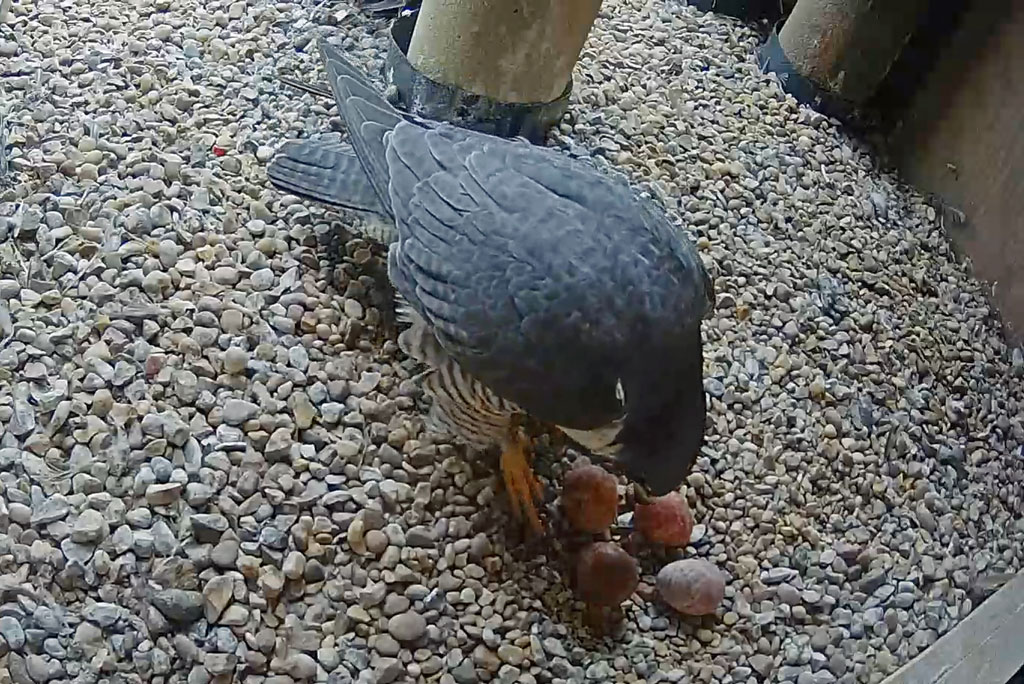
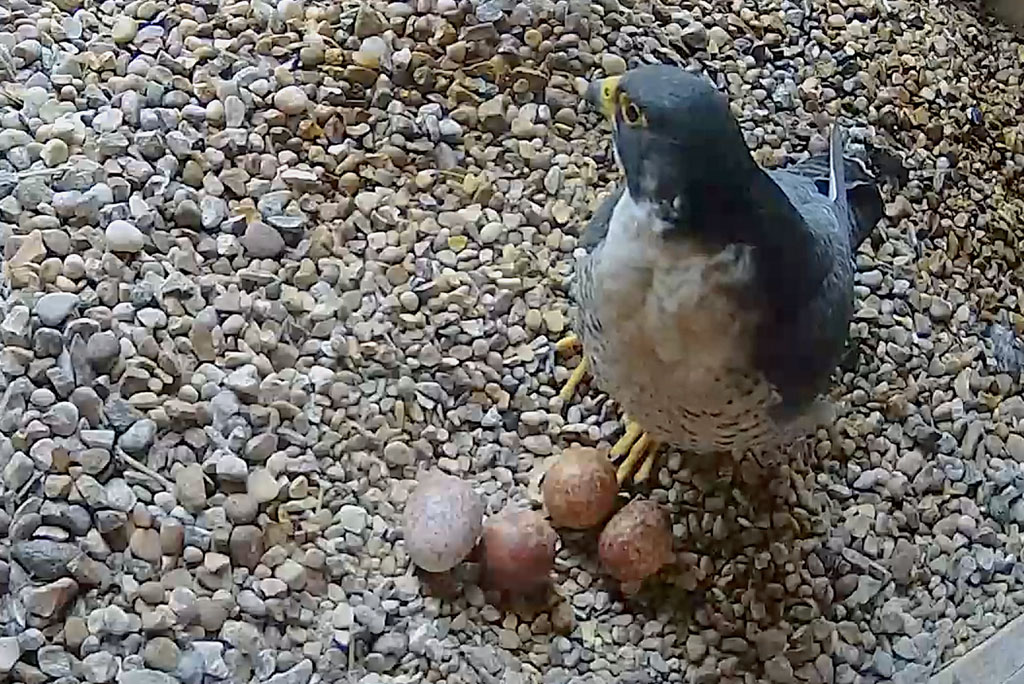
Whilst this was going on, the actions of the pair still indicated that there were frequent intrusions into the area. This resulted in the female leaving the eggs for extended periods and the male doing unusually long stints of incubation including one lasting four hours and 15 minutes. Throughout early April, the female continued to leave the eggs for periods to fend off intruders. Often the male replaced her but at times the eggs were unattended. This was in contrast to 2019, when there was just one period of five minutes through the whole of April when the eggs were not covered. The disruption then seemed to settle down until the 22nd when the female’s behaviour in particular changed and it was obvious there was another aggressive female in the area and the pair became increasingly distressed. At one point, the male landed at such speed that he almost knocked the female off the eggs, having been chased by the intruder.
Things took a turn on April 26th when the female arrived on the ledge with blood on her chest, obviously the result of an altercation. Review of video for that day showed another female flew past the platform whilst the resident pair looked out.
It was all change on the morning of the 27th when the resident pair left the box at 05:30. At 06:50, the male landed but took off immediately as the intruding female rushed into the box calling loudly and looking into the sky. She stood on the ledge at 07:15 and is dive-bombed by the resident female; she had effectively taken over the nest site. She occasionally left the box and the male tried to incubate the eggs whilst she was away; he flew out quickly on her arrival.
At 10:55 the new female walked to the back of the box and was immediately confronted by the resident female. What followed was one of the most vicious but compelling spectacles I have witnessed in the natural world and was not for the faint hearted. The two females were very evenly matched, and during the fight, each had the other on their backs. Both birds were injured on the chest by the talons of their opponent and blood was drawn. There were large periods where their talons were interlocked. They tried to gouge out eyes and attempted to bite the back of the neck on a number of occasions. There were periods where the pair broke free and they were posturing, even seeming to be playing tactics, hoping to catch the other off guard. They called loudly and aggressively throughout and the eggs were knocked from the scrape but surprisingly, did not appear to have been damaged.
Two hours and 15 minutes later and they were still interlocked. The new female managed to force the resident bird backwards out of the box. However, neither would release their grip and they tumbled off the platform with talons still interlocked. This is the last time the resident female was seen on camera, although she was still in the area as the new female defended the nest site.
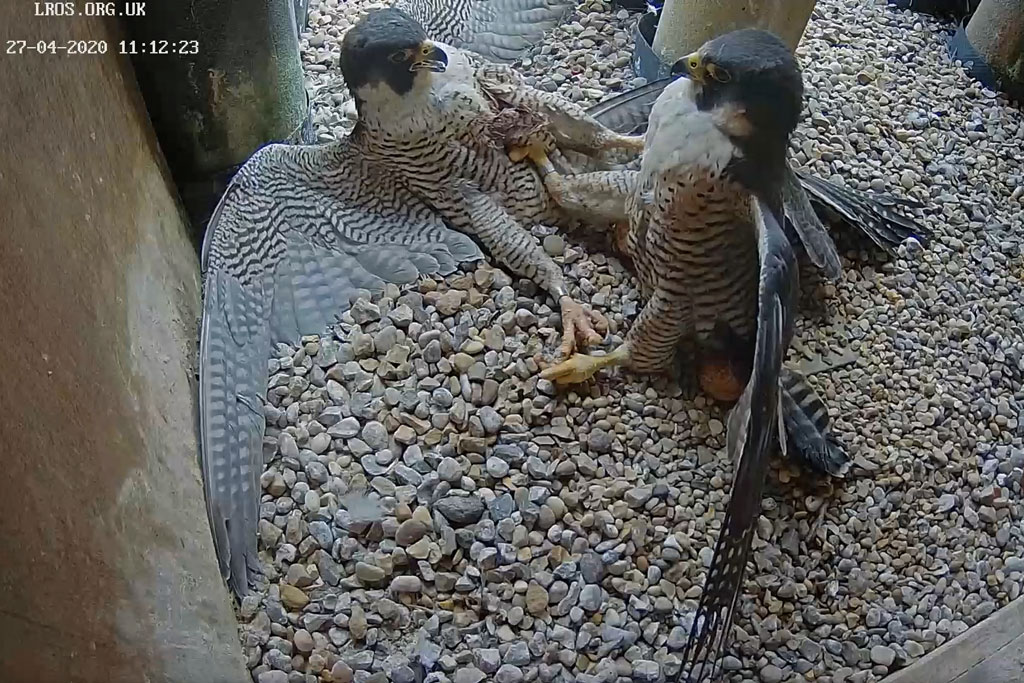
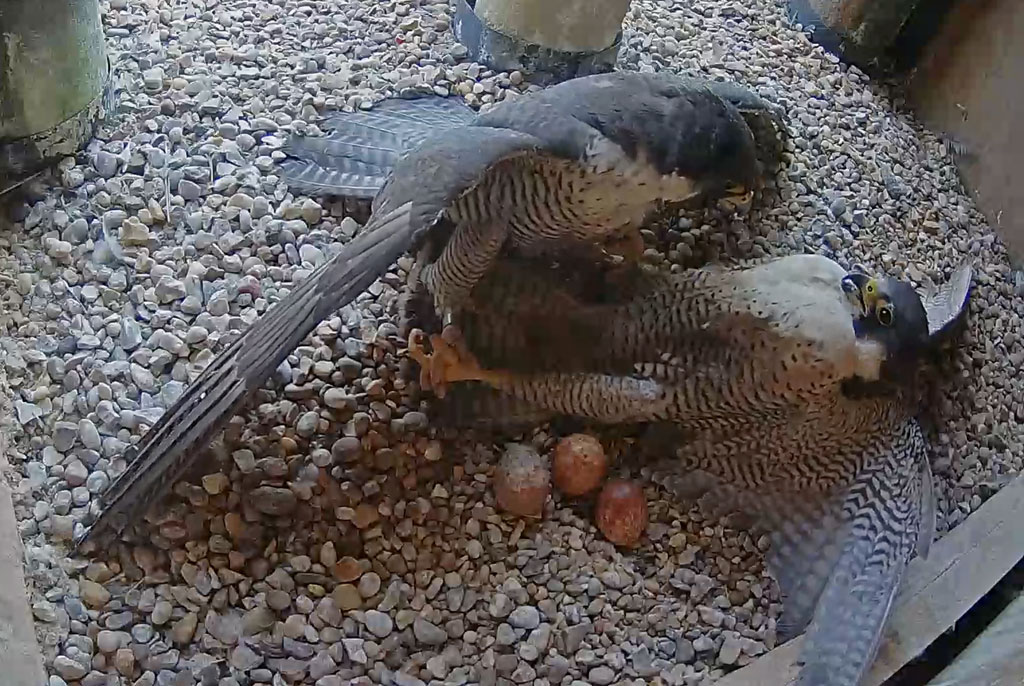
From that day on, the male tried to bond with the new female and simultaneously continue incubation of the eggs that were just days from hatching. Unfortunately, the eggs were scattered during the fight and just two remained near the scrape. He tried to push the closest displaced egg towards the scrape and eventually managed to partly cover it. All his efforts were in vain as he had to leave them each time the new female returned to the platform. The new female was conscious of the eggs and occasionally moved them with her foot.
Over the next few days, the male spent more time on the ledge whilst the female remained in the box and they started to gradually bond despite the resident female still being in the area.
Strangely, in the early hours of the morning on May 1st, the male covered the eggs whilst the new female was on the ledge. Later, she started to make scrapes in the stones but did not attempt to cover the eggs. Their bond grew stronger and by the evening of May 2nd, they remained on the platform overnight. On May 4th, the male brought in Starling prey for the new female which could possibly be construed as courtship feeding. They got closer than at any time and he began to feel comfortable in her presence and sat in a scrape created by the new female. Bizarrely, on May 7th, the female tried to bring the two outlying eggs together and covered them for a few minutes before leaving.
There appeared to be a reduction in conflict activity and the pair became settled and continued to bond through the month. The male stopped trying to cover the eggs by May 9th. He continued to bring in food for the female to cement their bond. The closeness of their bond was evident by May 20th when they could be seen touching beaks for the first time. Fascinatingly, the female started to have more interaction with the eggs and moved them with her beak and even ‘covered’ them for a few minutes. Even more incredible was that on the 22nd, the male dragged one of the eggs into the new scrape that the pair had been preparing. A few minutes later, the female arrived and ‘incubated’ it for a full five minutes. On the 29th, the female dragged two other eggs towards the scrape. The following day, after a bought of bonding in the box, the female ‘incubated’ the two eggs just outside the scrape for five minutes, and on the 31st she covered the eggs for over an hour. Although undamaged, all the eggs by now were unviable.
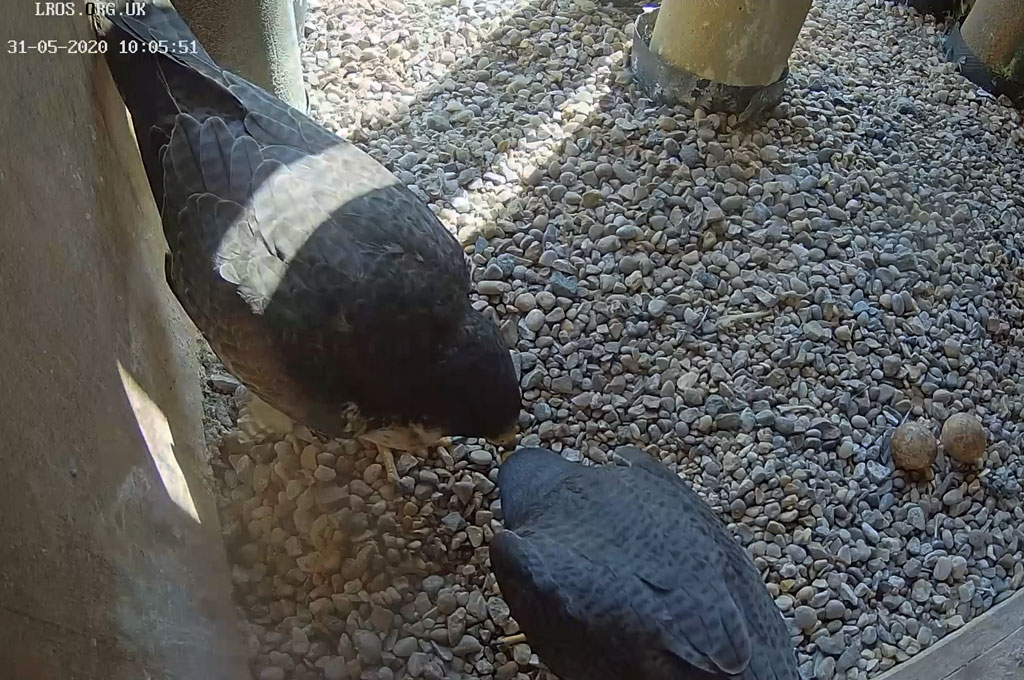
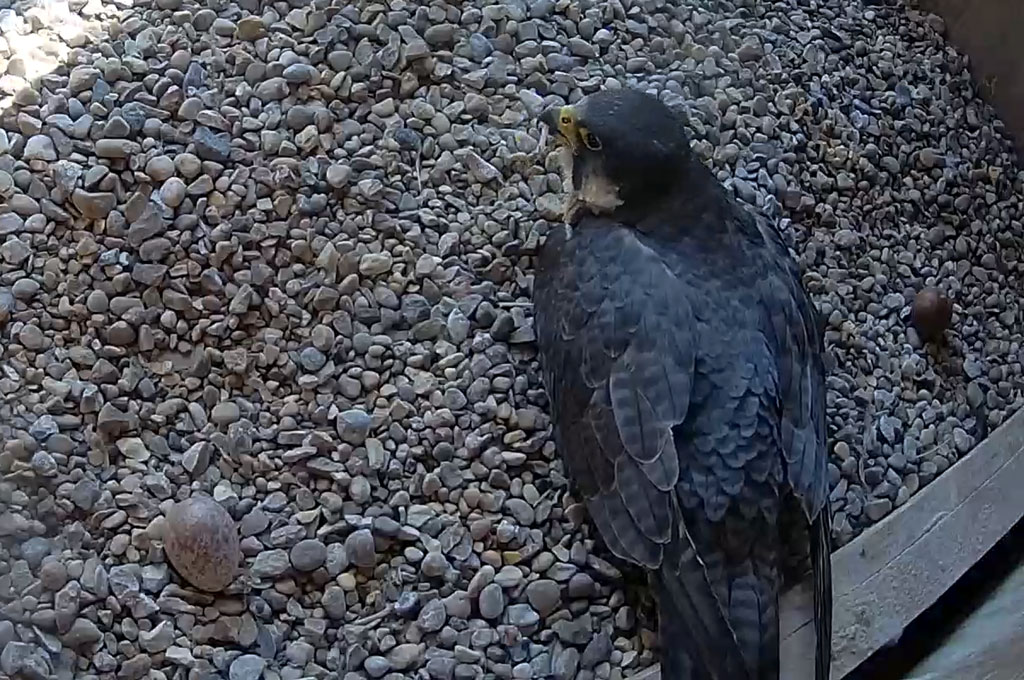
Throughout June, the pair continued to tighten their bond with plenty of calling and posturing in the box but spent less time interacting with the eggs, the male occasionally checking them. On June 14th, it was noted that at least one of the eggs was pitted and became more damaged over the next week. On the morning of the 20th, the female carried the damaged egg onto the platform. Later the same day, she checked out another egg and damaged it with her break and carried it to the platform. There were now just two eggs remaining in the box. On the 23rd, the male ran from the box to the platform and accidentally kicked one of the damaged eggs over the edge of the platform. Throughout the rest of the month both birds were regularly in the box and continued the bonding process. This became less intense towards the end of the month as they became more comfortable with each other’s presence.
During July and August, the pair continued to bond but spent less time in the box and more preening and resting on the platform and ledge. As they had been ignoring the remaining two eggs, it was decided to remove them and send them to Sheffield University to be analysed and their DNA profiles added to the national database. (A full report is available here).
The bonding pattern continued during the first week of September. However, after the 6th, this female was not seen on camera again, but the male returned to the ledge daily. Nothing in their demeanour prior indicated the presence of an intruder. Then on the 21st, the male called from the platform and another new female arrived. She was an orange colour-ringed bird, and the third female of the year. I eventually managed to read the ring [TFB] and it was confirmed that she was ringed as a pulli in central Birmingham in 2018, so was just two years old.
Unfortunately, there was a problem with the cameras streaming during October and due to Covid restrictions, we were unable to rectify immediately. When they came back online in November, the bonding between the male and the new inexperienced female was well advanced and scrapes were being made in the box. This continued until the end of the year and after the trauma in April, it was looking good for 2021.
In summary, the following are the dates of female occupations:
Resident female (1), from January 1st until April 26th producing four eggs.
Warwickshire ringed bird (2), from April 26th until September 6th.
Birmingham ringed bird (3), from September 21st until December 31st.
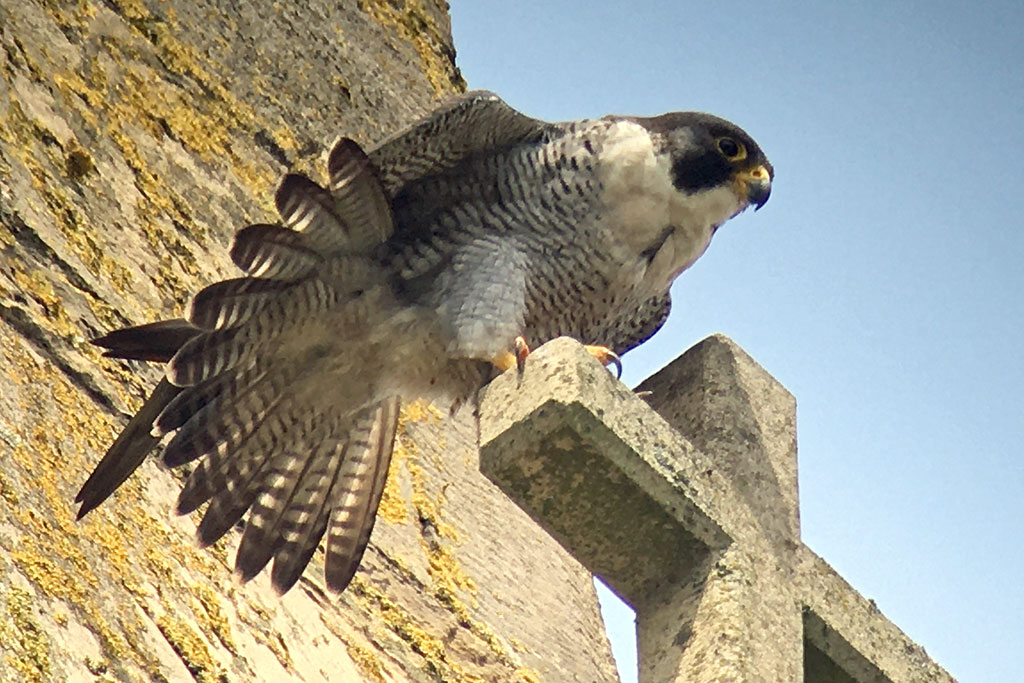
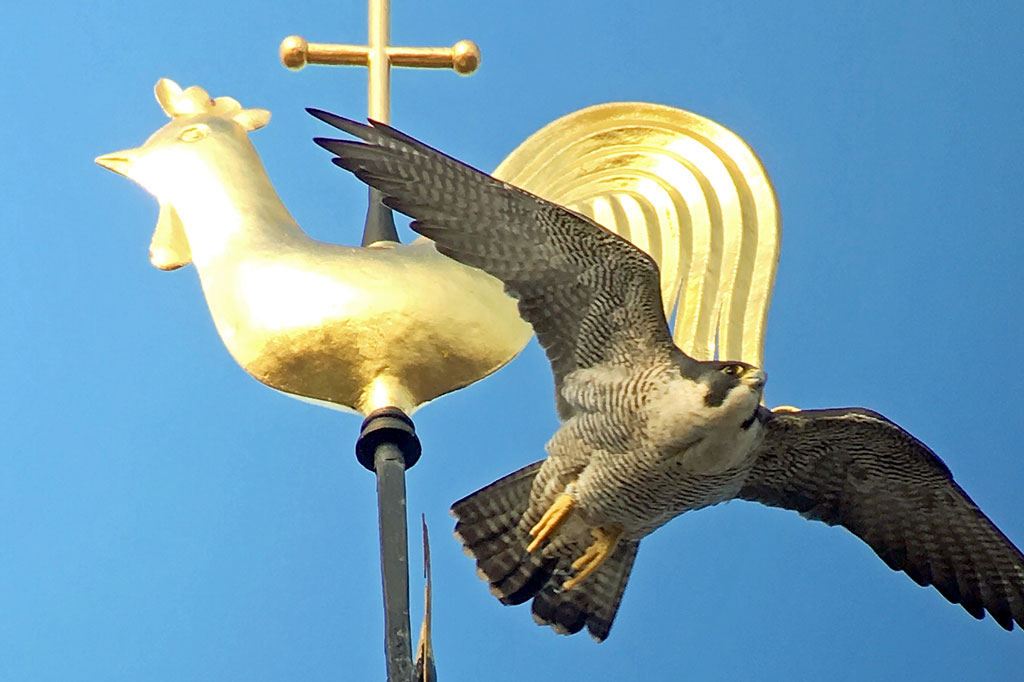
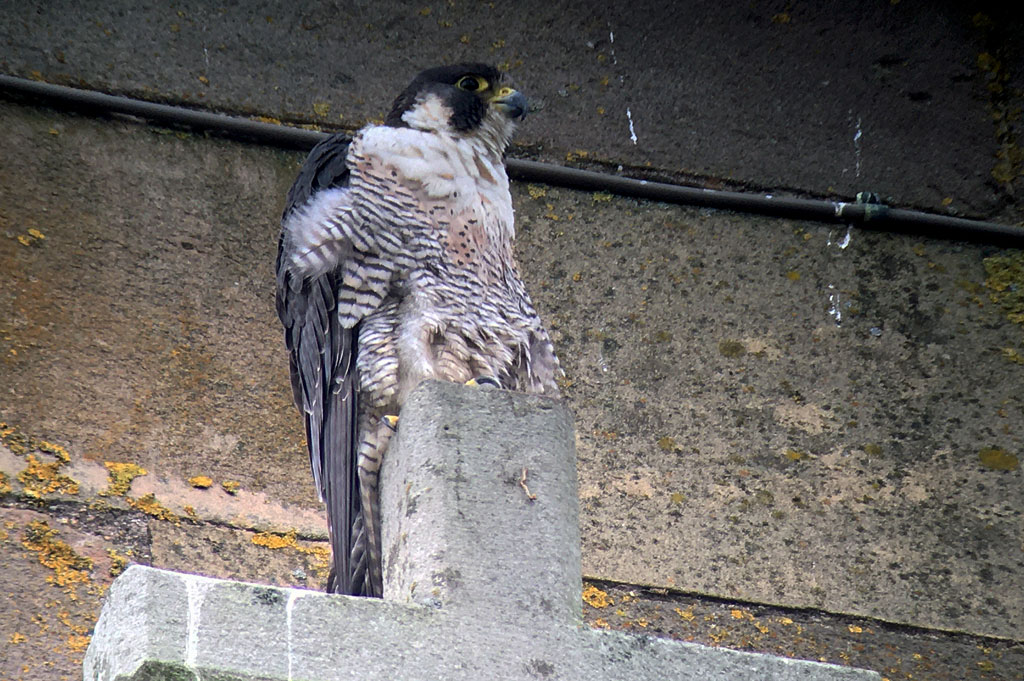
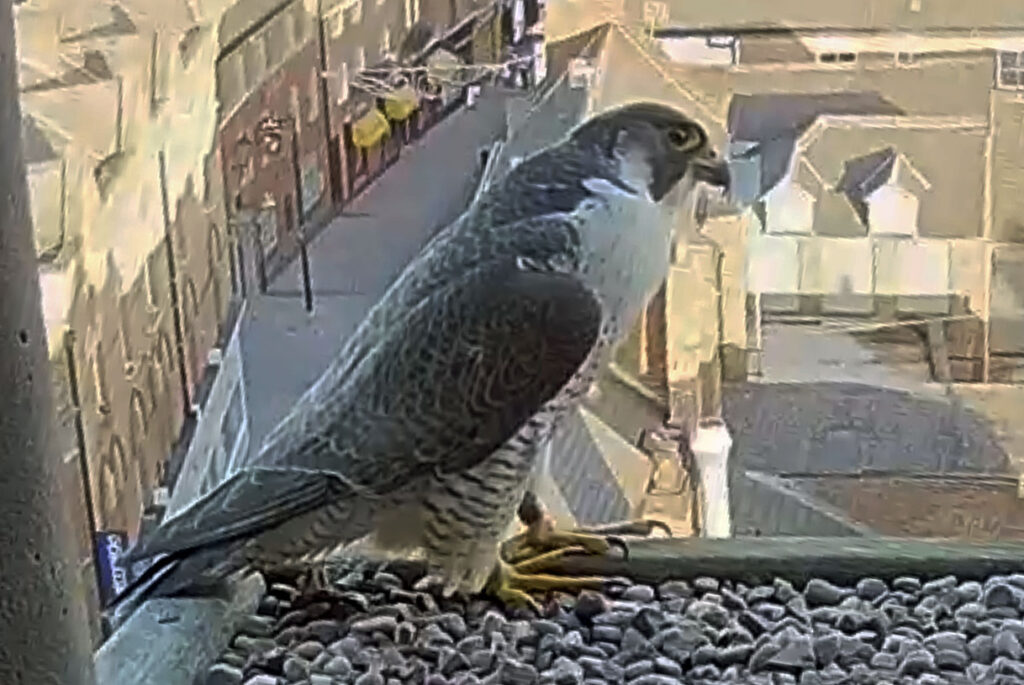
Prey Details
Of the 101 items of prey brought into the box, we were able to identify 95. Of these, 50 were Feral Pigeon and 17 Starling. Other species identified were: Blackbird (2), Blackcap (1), Chaffinch (1), Cockatiel (1), Common Tern (4), Fieldfare (4), Golden Plover (2), Great Spotted Woodpecker (1), Little Grebe (3), Redwing (2), Rook (1), Snipe (1), Stock Dove (1), Teal (2), Water Rail (1), and Woodpigeon (1).
